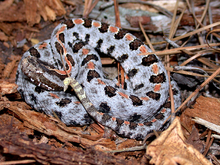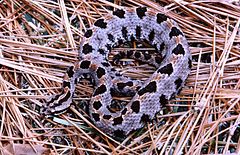- Sistrurus miliarius
-
Sistrurus miliarius 
Conservation status Scientific classification Kingdom: Animalia Phylum: Chordata Subphylum: Vertebrata Class: Reptilia Order: Squamata Suborder: Serpentes Family: Viperidae Subfamily: Crotalinae Genus: Sistrurus Species: S. miliarius Binomial name Sistrurus miliarius
(Linnaeus, 1766)Synonyms - [Crotalus] miliarius Linnaeus, 1766
- Crotalus miliarius Palisot de Beauvois, 1799
- C[rotalophorus]. miliarius Gray, 1825
- C[audisona]. miliaria Fitzinger, 1826
- Crotalophorus miliarius Holbrook, 1842
- C[rotalus]. (Crotalophorus) miliarius Jan, 1863
- [Sistrurus] miliarius Garman, 1884
- Sistrurus miliarius Boulenger, 1896
- Sistrurus miliarius miliarius Gloyd, 1935[1]
Sistrurus miliarius is a venomous pitviper species found in the southeastern United States. Three subspecies are currently recognized, including the nominate subspecies described here.[3]
Contents
Description
A small species with adults usually growing to 40–60 cm (16–24 in) in length. Maximum reported length are 78.8 cm (31.0 in) (Klauber, 1972). Snellings and Collins (1997) reported a specimen of S. m. barbouri measuring 80.3 cm (31.6 in), but it had been in captivity for over 12 years. The largest S. m. barbouri reported by Gloyd (1940) was a specimen measuring 63.8 cm (25.1 in) from St. Petersburg, Florida. Shine (1978) suggested that in some populations males may be larger than females, but a later study by Bishop et al. (1996) did not find sexual dimorphism of any kind in a population in Volusia County, Florida.[4]
The midbody rows of dorsal scales usually number 23. The dorsal pattern consists of a series of oval or subcircular spots with reasonably regular edges. The spots on the flanks are mostly round and not much higher than they are wide. Belly pigmentation towards the rear is more limited to indistinct blotches found on pairs of adjacent scales.[2] Juveniles have a color pattern that is similar to the adults, although it may be paler or more vividly marked, and the tip of the tail is yellow.[4]
Common names
Bastard rattlesnake, Carolina ground rattlesnake, Brick red rattlesnake (Hyde county) Carolina pigmy rattlesnake, Catesby's small snake, dwarf rattlesnake, eastern pigmy rattlesnake, grey rattlesnake, ground rattler (Garman, 1887), ground rattlesnake, hog-nosed rattlesnake, little rattlesnake, miliar(y) rattlesnake, North American smaller rattlesnake, oak-leaf rattler, pigmy ground rattlesnake, pigmy rattlesnake, small rattlesnake, southeastern ground rattlesnake, southern ground rattlesnake, southern pigmy rattlesnake, spotted rattler, spotted rattlesnake,[2] southern rattlesnake.[5]
Geographic range
Found in the southeastern United States from southern and eastern North Carolina, south through peninsular Florida and west to eastern Texas and Oklahoma. The type locality given is "Carolina." Schmidt (1953) proposed that this be restricted to "Charleston, South Carolina."[1]
Habitat
This species reportedly inhabits flatwoods, sandhills, mixed forests, floodplains, and is also found near lakes and marshes.[1]
Conservation status
This species is classified as Least Concern (LC) on the IUCN Red List of Threatened Species (v3.1, 2001).[6] Species are listed as such due to their wide distribution, presumed large population, or because it is unlikely to be declining fast enough to qualify for listing in a more threatened category. The population trend is stable. Year assessed: 2007.[7]
Behavior
Usually seen in the summer sunning themselves or crossing the road later in the day. The tiny rattle makes a buzzing sound that can only be heard from a few feet. Some individuals are very aggressive and will strike furiously, while others seem lethargic and do not even attempt to rattle.[8][9] They do not dig their own burrows, but rather use those dug by small rodents or Gopher Tortoises (Gopherus polyphemus).[10][11]
Feeding
Its diet includes small mammals and birds, lizards, insects and frogs,[2] as well as other snakes.[8][9]
Venom
Since this species is unable to produce much venom, it is unlikely that it is able to deliver a fatal bite to a human adult.[12] Brimley (1942) wrote that although it was too small to be really dangerous, its bite "will give the victim quite an unpleasant time for several days."[2] However, bites involving children have resulted in prolonged hospitalization and there are also reports of necrosis.[12]
These snakes produce venom that is strongly hemorrhagic and tissue toxic, but devoid of any neurotoxins (Ernst, 1992; Van Mierop, 1976). It is somewhat different in that it contains substantial amounts of serotonin and related tryptamine compounds (Welsh, 1967). Antivenin does not appear to be effective in the treatment of these bites, although CroFab does seem to do a better job than ACP, at least in some animal models. (Consroe et al., 1995).[12]
Subspecies
Subspecies[3] Taxon author[3] Common name[13] Geographic range[13] S. m. barbouri Gloyd, 1935 Dusky pigmy rattlesnake The United States from extreme southern South Carolina through southern Georgia, all of Florida, west through southern Alabama and southeastern Mississippi. S. m. miliarius (Linnaeus, 1766) Carolina pigmy rattlesnake The United States from extreme southern South Carolina, northwards into eastern North Carolina as far as Hyde County and west through central Georgia and central Alabama. S. m. streckeri Gloyd, 1935 Western pigmy rattlesnake The United States in Mississippi (except for southeast of the Pearl River Valley), west through Louisiana into eastern Texas, and north into southeastern Oklahoma, Arkansas, southern Missouri and southwestern Tennessee. See also
- List of crotaline species and subspecies
- Crotalinae by common name
- Crotalinae by taxonomic synonyms
- Snakebite
References
- ^ a b c McDiarmid RW, Campbell JA, Touré T. 1999. Snake Species of the World: A Taxonomic and Geographic Reference, vol. 1. Herpetologists' League. ISBN 1-893777-00-6.
- ^ a b c d e Wright AH, Wright AA. 1957. Handbook of Snakes. Comstock Publishing Associates. (7th printing, 1985). 1105 pp. ISBN 0-8014-0463-0.
- ^ a b c "Sistrurus miliarius". Integrated Taxonomic Information System. http://www.itis.gov/servlet/SingleRpt/SingleRpt?search_topic=TSN&search_value=174302. Retrieved 28 February 2007.
- ^ a b Campbell JA, Lamar WW. 2004. The Venomous Reptiles of the Western Hemisphere. Comstock Publishing Associates, Ithaca and London. 870 pp. 1500 plates. ISBN 0-8014-4141-2.
- ^ U.S. Navy. 1991. Poisonous Snakes of the World. US Govt. New York: Dover Publications Inc. 203 pp. ISBN 0-486-26629-X.
- ^ Sistrurus miliarius at the IUCN Red List. Accessed 15 September 2007.
- ^ 2001 Categories & Criteria (version 3.1) at the IUCN Red List. Accessed 15 September 2007.
- ^ a b Behler JL, King FW. 1979. The Audubon Society Field Guide to North American Reptiles and Amphibians. New York: Alfred A. Knopf. 743 pp. LCCCN 79-2217. ISBN 0-394-50824-6.
- ^ a b Conant R. 1975. A Field Guide to Reptiles and Amphibians of Eastern and Central North America. Second Edition. First published in 1958. Houghton Mifflin Company Boston. 429 pp. 48 plates. ISBN 0-395-19979-4. ISBN 0-395-19979-8 (pbk.).
- ^ Animal Diversity-U. of Michigan (Downloaded Feb. 18, 2010.)
- ^ Ernst, C., R. Barbour. 1989. Snakes of Eastern North America. Fairfax, Virginia: George Mason University Press.
- ^ a b c Norris R. 2004. Venom Poisoning in North American Reptiles. In Campbell JA, Lamar WW. 2004. The Venomous Reptiles of the Western Hemisphere. Comstock Publishing Associates, Ithaca and London. 870 pp. 1500 plates. ISBN 0-8014-4141-2.
- ^ a b Klauber LM. 1997. Rattlesnakes: Their Habitats, Life Histories, and Influence on Mankind. Second Edition. First published in 1956, 1972. University of California Press, Berkeley. ISBN 0-520-21056-5.
External links
- Sistrurus miliarius at the Reptarium.cz Reptile Database. Accessed 15 September 2007.
- Sistrurus miliarius at University of Texas - Herps of Texas. Accessed 30 November 2006.
- The Pigmy Rattlesnake Homepage (Sistrurus miliarius) at Stetson University Biology Department. Accessed 30 November 2006.
Categories:- IUCN Red List least concern species
- Crotalinae
- Reptiles of the United States
- Fauna of the Southeastern United States
Wikimedia Foundation. 2010.


